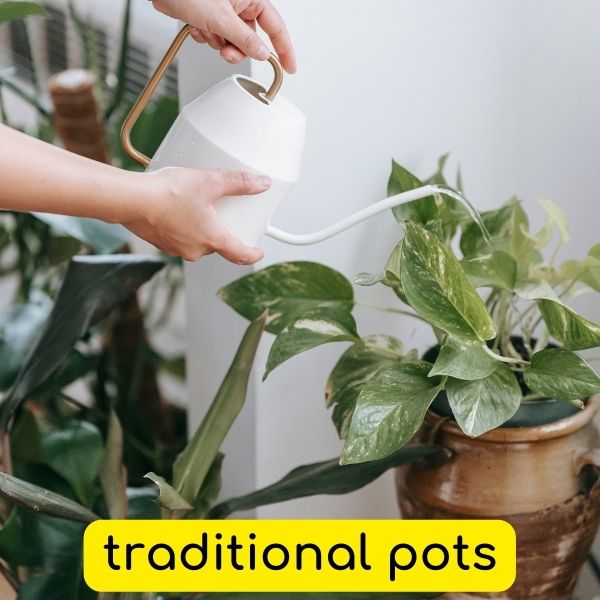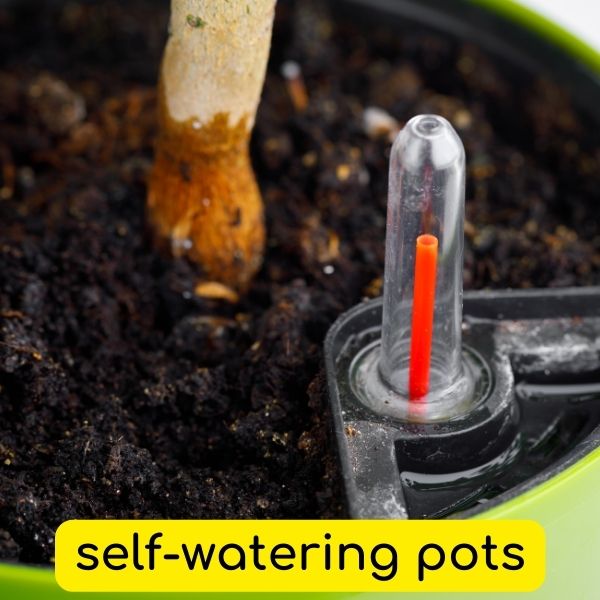Welcome to container gardening – a fusion of nature’s bounty and human creativity. As you prepare to sink your fingers into the rich soil, you’ll encounter two choices: traditional pots and self-watering pots. Countless gardeners have used both options for centuries.
If you’re excited to try gardening with pots for the first time, you’ve come to the right place. This comprehensive guide will help you understand the dynamics of each and aid in your journey from a novice to an expert gardener.
Difference Between Traditional Pots And Self-Watering Pots
At first glance, traditional pots are simple garden containers waiting to be filled with soil and a plant. They range from classic terracotta and metal to fancy ceramic and fiberglass. Traditional potted plants often require frequent, manual watering since the design and structure of these pots can’t permanently preserve water and nutrients in the soil.
On the other hand, indoor and outdoor self-watering pots seem almost alien, boasting a reservoir system that hydrates your plants as per their needs. These futuristic pots are versatile and cater to plants outside or inside your home. The main difference lies in their functions, not their appearance.
Pros And Cons Of Traditional Pots

Traditional pots and self-watering pots have both been used by gardeners for centuries. Yet many still use the former for their indoor or outdoor gardens. Consider their pros and cons listed below:
Pros
- They’re inexpensive and easy on the pocket.
- They suit varied tastes with the range of available sizes and styles.
- Readily available at most gardening stores.
Cons
- Achieving the right balance in watering can be challenging.
- Plants are at risk of being overwatered or underwatered.
- They lack the water efficiency that self-watering pots provide.
The appeal of traditional pots is their simplicity. Even with their cons, many gardeners swear by these pots since they allow full control over the watering process, despite the risk of human error.
Pros And Cons Of Self-Watering Pots
Next, venture into the land of self-watering pots, a concept many gardeners are also new to. Here are their advantages and disadvantages:
Pros
- They save precious time and water.
- They can help to reduce the risk of overwatering or underwatering.
- Ideal for gardeners who have busy schedules or travel frequently.
Cons
- They are pricier than traditional pots.
- The options of available sizes and styles are less vast.
- They can be challenging to find in traditional gardening stores.
Despite their higher price, the time and worry saved make self-watering pots a worthy investment, especially for those on the go. These pots could also be a fantastic choice for first-time gardeners.

Types Of Self-Watering Pots
There’s more to self-watering pots than meets the eye. If you have a particular preference for a pot’s type and material, you’ll be happy to know that they come in several variants:
- Wicking pots: A wick connects the soil and the water reservoir, acting as a channel for water to move upwards—much like how humans use straws!
- Reservoir pots: These pots have a built-in water tank that slowly quenches the soil’s thirst over time.
- Water globe pots: These self-watering pots incorporate a water globe that gradually releases water into the soil.
Self-watering pots also come in three materials, namely:
- Plastic
- Ceramic
- Fiberglass
Each type offers a unique solution to the constant gardener’s dilemma: keeping plants hydrated but not drowning. Besides that, the different options give you a choice of what you want to have outside or on your balcony or patio garden.
How Self-Watering Pots Work
Self-watering pots work by capillary action. Capillary action is the force that draws water up through small spaces. In a self-watering pot, the water reservoir is located at the bottom of the pot. A platform or barrier with small openings or wicks separates the soil from the reservoir.
When the soil dries out, the wicks draw up water from the reservoir and into the soil. The soil is hydrated by water reaching up from the reservoir through these wicks. This process ensures that the plants always have a steady water supply, without risk of waterlogging, even on non-watering days.
How To Choose The Right Self-Watering Pots
Choosing the right self-watering pot is similar to choosing a new car—it depends on your needs, preferences, and budget. Think about your plant’s size and water requirements. Also, factor in your travel frequency and the time you can dedicate to plant care.
If you’re particular about cleanliness in your garden, consider a self-watering pot made of an easy-to-clean material. Finally, note that a pot is more than a container to hold your plants. It’s an integral part of your garden aesthetics or indoor decor.
How To Care For Plants In Self-Watering Pots
While self-watering pots may feel like magic, they do not absolve you of all plant care duties. Your plants will still need adequate sunlight, nutrient-rich soil, and occasional fertilizing.
You’ll need to monitor the water reservoir levels and refill when necessary. Most self-watering pots require refills every two weeks. But consult other gardeners or the pot’s manual for the right time to replenish the water. Also, regular pot cleaning is necessary to prevent algae or mold growth—a hidden hazard in self-watering systems. Continually inspect your plants for pests and diseases, even if they’re in your home or greenhouse.
Water-hungry crops such as garlic, onions, and lettuce could thrive in self-watering pots with proper care and maintenance. Given the right conditions, seasonal flowers and herbs will also do well in a self-watering pot.
The Takeaway: Self-Watering Pots Are Modern Twists To Traditional Pots
That brings you to the end of this exploration of traditional and self-watering pots. As you venture further into gardening, remember that choosing between the two types is not a question of right or wrong. It’s what suits you and your plants best. Your love and care for your plants matter more than the pots you use.
So step into the gardening world with a spirit of curiosity and delight. Remember, every thriving garden—like every beautiful story—begins with a single pot and a seed of passion. Happy gardening!

